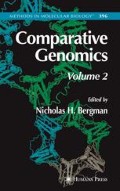Summary
DNA microarrays can be used to detect polymorphic loci in addition to identifying genes or regions that are absent within a genome. A survey such as this offers greater insight into the level of diversification within a species or population, which is useful in organisms that have nearidentical genomic content but differ in phenotype. The identification of such variable loci can then lead to the characterization of genes linked to unique biological attributes. Here, we describe a competitive hybridization assay using DNA microarrays as a comparative genomics tool to identify nucleotide polymorphisms among closely related strains of Chlamydia trachomatis.
Access this chapter
Tax calculation will be finalised at checkout
Purchases are for personal use only
References
Brunelle, B. W., Nicholson, T. L., and Stephens, R. S. (2004) Microarray-based genomic surveying of gene polymorphisms in Chlamydia trachomatis. Genome Biol. 5, R42.
Stephens, R. S. (1999) Genomic autobiographies of Chlamydiae, in Chlamydia: Intracellular Biology, Pathogenesis, and Immunity, (Stephens, R. S., ed.), American Society for Microbiology, Washington, DC, pp. 6–26.
Wang, S. P. and Grayston, J. T. (1988) Micro-immunofluorescence antibody responses to trachoma vaccines. Int. Ophthalmol. 12, 73–80.
Stephens, R. S., Kalman, S., Lammel, C., et al. (1998) Genome sequence of an obligate intracellular pathogen of humans: Chlamydia trachomatis. Science 282, 754–759.
Nicholson, T. L., Olinger, L., Chong, K., Schoolnik, G., and Stephens, R. S. (2003) Global stage-specific gene regulation during the developmental cycle of Chlamydia trachomatis. J. Bacteriol. 185, 3179–3189.
Read, T. D., Brunham, R. C., Shen, C., et al. (2000) Genome sequences of Chlamydia trachomatis MoPn and Chlamydia pneumoniae AR39. Nucleic Acids Res. 28, 1397–1406.
Dong, Y., Glasner, J. D., Blattner, F. R., and Triplett, E. W. (2001) Genomic interspecies microarray hybridization: rapid discovery of three thousand genes in the maize endophyte, Klebsiella pneumoniae 342, by microarray hybridization with Escherichia coli K-12 open reading frames. Appl. Environ. Microbiol. 67, 1911–1121.
Kim, C. C., Joyce, E. A., Chan, K., and Falkow, S. (2002) Improved analytical methods for microarray-based genome-composition analysis. Genome Biol. 3, RESEARCH0065.
Lindroos, H. L., Mira, A., Repsilber, D., et al. (2005) Characterization of the genome composition of Bartonella koehlerae by microarray comparative genomic hybridization profiling. J. Bacteriol. 187, 6155–6165.
McConaughy, B. L., Laird, C. D., and McCarthy, B. J. (1969) Nucleic acid reassociation in formamide. Biochemistry 8, 3289–3295.
Acknowledgments
We would like to thank Dr. Eric M. Nicholson for his critical evaluation regarding the manuscript. We would also like to thank Dr. Gary Schoolnik and the members of his lab for their technical assistance with the microarray procedures described here. This work was performed in the laboratory of Dr. Richard S. Stephens, and we are grateful the support he provided. Mention of trade names or commercial products in this article is solely for the purpose of providing specific information and does not imply recommendation or endorsement by the US Department of Agriculture.
Author information
Authors and Affiliations
Editor information
Editors and Affiliations
Rights and permissions
Copyright information
© 2007 Humana Press Inc.
About this protocol
Cite this protocol
Brunelle, B.W., Nicholson, T.L. (2007). Microarray-Based Approach for Genome-Wide Survey of Nucleotide Polymorphisms. In: Bergman, N.H. (eds) Comparative Genomics. Methods In Molecular Biology™, vol 396. Humana Press. https://doi.org/10.1007/978-1-59745-515-2_17
Download citation
DOI: https://doi.org/10.1007/978-1-59745-515-2_17
Publisher Name: Humana Press
Print ISBN: 978-1-934115-37-4
Online ISBN: 978-1-59745-515-2
eBook Packages: Springer Protocols

